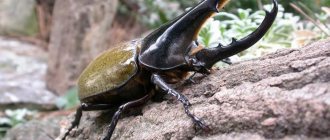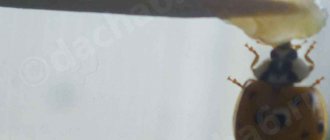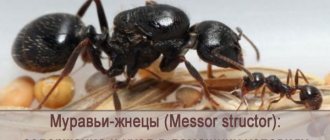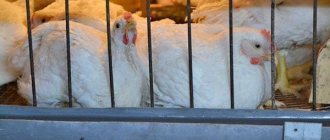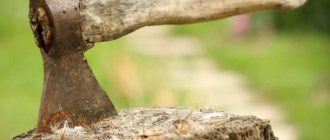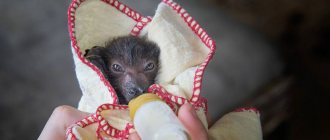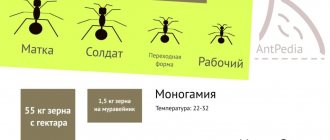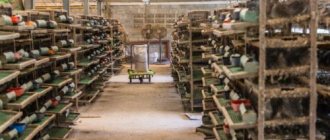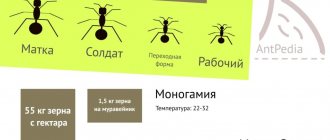Natural enemies of the swimming beetle
This insect causes significant damage to fish farms, especially at the initial stage of fish farming, when the beetle can prey on small fish.
After the life of this seemingly very small predator, fish farms do not have a large number of young fish. It should be noted that the diving beetle also has its enemies, which regulate its numbers in water bodies. Otherwise, serious measures would have to be taken to combat this natural pest of water bodies. The swimming beetle is hunted by larger predatory fish species, many birds, including seagulls, as well as mammals inhabiting water bodies. Some living creatures are interested not only in the adult beetle, but also in its larva
It is worth paying attention to the special natural enemy of the larvae of the diving beetle - this is the ichneumon insect. The peculiarity is that the female ichneumon, having found the eggs of the diving beetle, lays her eggs in them, which develop due to the nutrient medium of the beetle eggs
After the wasp larva has eaten all the supplies, it pupates. After some time, an adult insect, the ichneumon ichneumon, emerges from the egg of the swimming beetle.
Therefore, despite the high fertility of this predator, its populations in water bodies are maintained at an optimal level by natural enemies, which prevents it from having a serious impact on the populations of various fish species.
Features of the structure of the insect
The description of the swimming beetle has much in common with other representatives of this family. This is a fairly large insect - the body length of the swimmer is about 4.5 cm. Most representatives of this family are black in color. There is also a brown coloration of the diving beetle with an olive tint. The long, streamlined body allows the beetle to move easily in the water.
The body of an insect has three parts of the body that are motionlessly articulated with each other: the abdomen, head and chest. Moreover, the insect's head is pressed into the chest, which smoothly passes into the abdomen due to the fused thoracic segments.
Banded swimmer
There are compound eyes on both sides of the head. They are called that because they consist of many simple eyes (about 9 thousand). This allows the insect to distinguish between objects and the plant world around it. The antennae act as organs of touch and smell. The insect's oral apparatus is presented in the form of strong jaws, thanks to which the beetle grabs and crushes its prey. A diagram of the structure of the swimmer and a diagram with captions are presented below.
The insect is held on the plant by two front pairs of legs, which have a grasping reflex. The delicate wings are protected by hard elytra, which are characteristic of all beetles of this family. This structure of the diving beetle allows it not only to swim, but also to fly, which helps the insect, if necessary, change its habitat. Although he does this only in extreme cases, for example, when a pond dries up. The beetle uses its hind pair of legs as oars. Below you can see what the swimming beetle looks like in the photo.
On the ground, the swimming beetle moves rather slowly, waddling from side to side. While walking, he moves with his front paws, and the back pair of legs serves for pushing off.
The most favorite habitat of swimming beetles are bodies of standing water with thickets of algae. Moreover, the strongest individuals are able to live even in a ditch or puddle.
Planarians
Unlike hydras, planaria lead a crepuscular lifestyle, hiding during the day in the thick of plants or under stones. If you look at caught planarians under a magnifying glass, you can see two ocelli on the front of the body. The body of the planaria is covered with cilia and its movements look smooth. Worms are covered with a specific mucus, so fish, with the exception of a few, which we will talk about below, do not eat them.
Planarians are unusually tenacious. When exposed to unfavorable conditions, the worms lose mobility, turning into a shapeless mass, but the throat of the planaria, which can live independently, breaks away from the body and goes out into the environment, continuing to move. Worms are capable of amazing regeneration. Even divided into more than two hundred and fifty parts, the planaria retains the ability to restore a new, full-fledged organism from each part. Methods of fighting this tenacious predator are based on its highly developed sense of smell. A little scraped beef is placed in a gauze bag and lowered onto a fishing line into the aquarium, not far from plants or from the ground. The aquarium is darkened. Planarians will gather on the bait quite quickly. The bag is taken out with a net in low light and immersed in boiling water. This procedure is repeated at intervals of several days.
An increase in temperature to 30-32° C, which many tropical fish can withstand (provided there is sufficient aeration), is detrimental to planaria.
In conclusion, a few words about fish that do not hesitate to eat worms such as planaria, and which experienced aquarists have always relied on. These are young gouramis, macropods, and cockerels. Recent observations have added to this list the names of new “fighters” against planarians: juveniles of black-striped cichlazoma, chromis, bulli, and olecostoma. In this case, the fish should not be fed for two to three days.
Chemical methods of controlling planaria are also acceptable. Copper sulfate (1.5 mg per 1 liter of water) and ammonium nitrate (25-50 mg per 1 liter of water with double treatment) are used.
The aquarist also has other enemies.
The invasion of parasitic algae for many aquarium lovers sometimes becomes an unbearable disaster. Experienced aquarists are also baffled by an unexpected, at first glance, explosion in the number of, for example, blue-green algae.
Hydra
The massive development in aquariums of dangerous representatives of coelenterates - hydras - can become very unpleasant. Having attached itself to the glass of the aquarium, plants, and other objects with its sole, the hydra does not fall with the help of tentacles onto the larvae and fry of fish. The tentacles are equipped with cells with stinging capsules containing thin threads with poison, with which the hydra paralyzes the victim, and then captures and absorbs it. At the same time, the predator increases significantly in size.
The length of the hydra's body without tentacles reaches 1 cm. In larger fry, the hydra breaks the skin, opening access to infection.
Hydra can reproduce very quickly by budding. It is photophilous, and you can see a cluster of hydras on a brightly lit area of the glass of the aquarium.
Getting rid of hydras is not so easy. There are several ways to fight, each of which has its own disadvantages, although those who offer them have achieved positive results.
The easiest way is to lure hydras into the light, given their positive phototaxis. In this case, thin glass is lowered into the aquarium, which is pressed against the glass of the aquarium. The aquarium is shaded and a beam of light is directed onto this glass. When hydras accumulate in an illuminated area, the glass with them is removed and the attached hydras are cleaned from it. Naturally, this method cannot completely get rid of hydra, so they suggest fighting hydra using chemicals, in particular ammonium sulfate [(NH4)2S04)] or ammonium nitrate (NH4N03). Ammonium sulfate is dissolved at the rate of 0.05 g of the substance per 1 liter of water and added to the general aquarium, since it is harmless to fish in these doses. Hydras should die within 3-5 days. Using ammonium nitrate, fry and juvenile fish are removed from the aquarium. Before adding this salt, adult fish and hydras are intensively fed with daphnia for two weeks.
Hydras actively reproduce at this time. Then ammonium nitrate is added to the aquarium at the rate of 0.6-1 g of the substance per 10 liters of water, having previously dissolved the chemical in 250-500 ml of water. For better mixing, turn on aeration. The temperature is raised to 27-28° C and maintained until the end of the course of treatment. After three days, the procedure is repeated. Hydras should die on the fifth or sixth day. The water in the aquarium after the destruction of hydras is not completely changed: for fish, ammonium nitrate in such concentrations is harmless, and even serves as a fertilizer for plants.
If there are no plants in the aquarium and fish can be removed, hydrogen peroxide is sometimes used at the rate of two teaspoons of a 3% hydrogen peroxide solution per 10 liters of water. The calculated amount is diluted in 100-150 ml of water and added to the aquarium without fish and plants. The free oxygen formed in this case has a detrimental effect on hydra.
There is another way to get rid of uninvited aliens. Two balls of copper wire (without insulation), immersed in water at different ends of the aquarium, begin to oxidize. The resulting chemical reaction products have a detrimental effect primarily on lower plants (algae) and on hydras, which lose their tentacles. They fall to the bottom of the aquarium, from where they are removed with a hose. After freeing the aquarium from hydras, the wire is removed.
A solution of copper sulfate (0.05 g per 1 liter of water) was used to combat hydra. In this case, the death of the hydras occurs within an hour; after another 3-4 hours, partial cleaning and complete replacement of the water in the aquarium are carried out. The fish were removed from the aquarium during these operations. Copper sulfate must be chemically pure or analytical grade. In this case, I personally am not satisfied with a complete water change, i.e. in fact, a newly created aquarium. However, for spawning and rearing special aquariums, where plants are usually kept in pots or ditches (they are portable) and there is no soil, where water is taken from large aquariums, diluting it with tap water, i.e. where fish live temporarily, this method can be applied.
An interesting method of combating hydra without the use of chemicals. A method of fighting hydra using an eclectic current was tested and proposed by aquarist E. Dotsenko from Kharkov. It consists in the fact that a DC source of 9-12 V is connected to two bundles of copper wire (without insulation), immersed in water at opposite ends of the aquarium. It is possible to use a 9-12 V transformer with a diode single or full-wave rectifier). The current is turned on after installing the wiring, provided that the current-carrying wires are carefully insulated from the metal frame of the aquarium. One or two activations for 1-2 minutes are enough to destroy all hydras in a 60 liter aquarium. The fish and plants feel fine.
No less troublesome is the fight against other extremely undesirable guests of the aquarium - planaria. These flatworms, having, as one biologist puts it, a “rogue throat”, enter the aquarium along with live food and destroy eggs, larvae and fry of fish. Aquarists are familiar with three types of planaria: brown (Planaria torva), black (Polycoelis nigra) and the less common large milky white planaria (Dendrocoellum lacteum), reaching a length of 2.5 cm. It has been revealed that planaria are not at all so harmless in relation to adults fish. Their predatory attack on adult Malaysian cichlids was noted, for example, by scientists at the Dnepropetrovsk Aquarium Complex. Planarians were found in large numbers on the gills of dead fish. The death of the cichlids occurred as a result of severe anemia. The remaining fish were saved by adding sodium chloride (2.5 g per 1 liter of water).
Enemies of the swimmer
The consequence of the appearance of beetles in fish farms or artificial reservoirs can be the extermination of large numbers of fish. However, there are also creatures who eat the swimming beetle in a pond with great pleasure - these are various invertebrates, large fish, birds and mammals.
In moments of danger, swimmers secrete an unpleasant-smelling liquid, which has a deterrent effect.
The larvae of diving beetles also have enemies. We are talking about an aquatic parasitic insect - an ichneumon fly, which has the strange name of prestwichia. Having discovered the egg of a diving beetle, the female ichneumon lays her eggs in it. The resulting parasite larva will eat the insides of the victim's egg until it turns into a pupa. The already formed adult equestrian is released into the world.
This insect is carnivorous and belongs to the Coleoptera family. The swimming beetle quickly adapts to natural conditions, so it is not problematic to find it in the waters of Eurasia. In addition, it inhabits the waters of North America and is also found in Antarctic areas.
For its life activity, the beetle chooses bodies of water with stagnant water, which are rich in flora and fauna. The diet of the diving beetle includes objects of animal origin. He can even live in an aquarium if he is provided with all the necessary conditions and enough food.
Rules for aquarists
Tips for beginner aquarists:
- Watch the behavior and appearance of the fish. The color should be rich, the eyes should not be cloudy. If you have any suspicions, contact experienced aquarists, describing in detail the problem, the parameters of the aquarium and the features of keeping the fish.
- Keep in mind that even in a healthy aquarium, in addition to plants and fish, other small inhabitants appear (for example, ciliates or small insects).
- Maintain your aquarium on time. Incomplete care of the aquarium stimulates fish poisoning and decreased immunity.
- When introducing new fish, study information about them. They may be incompatible in terms of required water parameters or temperament.
- If the fish dies, immediately remove the corpse from the water. Determine the cause of death by external examination.
- If the fish shows signs of illness, place it in a separate container.
- Do not knock on the glass or interfere with the life of the inhabitants of your home aquarium unless necessary.
- When you start breeding fish, learn what you can’t do without for successful spawning, and how many males a female is placed with.
- To avoid damaging the walls of the aquarium, use a non-metallic scraper.
- If stones are collected from the street, test them for the presence of heavy metal ions with acetic or citric acid. Stones containing undesirable elements will react when they come into contact with acid. Boil the soil thoroughly to avoid introducing parasites into the aquarium. Driftwood collected from nature must also be thoroughly boiled.
- To prevent fish from jumping out of the aquarium, cover the container with a lid.
- Proper use of an aquarium siphon, connecting equipment or feeding fish is impossible without training and preparation, it will take a little patience before the aquarium hobby becomes productive.
Science points to fish's ability to sense and recognize faces. Aquatic pets have their own characteristics and range of sensations. Don’t be lazy to create comfort in the world of underwater inhabitants, because fish are sensitive and intelligent creatures.
Previous Aquarium Daily feeding using feeders for aquarium fish Next Aquarium Is it enough for the aquarium water to stand for just a few hours?
Swimming beetle: description
The beetle is quite large in size, for an insect. The length of its body reaches about 4.5 cm. The body is colored yellow, which is typical for representatives of this family, although there are diving beetles with a brown body color, as well as with an olive tint. The beetle's body is long and streamlined, which facilitates its movement in the water column.
The body of an insect consists of 3 parts: the abdomen, head and thorax, which are motionlessly connected into one whole. The insect's head is slightly pressed into the chest so that it smoothly passes into the abdomen, due to the pectoral segments.
On one and the other side of the head there are unique eyes, which consist of a collection of almost 9 thousand tiny simple eyes. With their help, the beetle masters the aquatic world. Whiskers serve as organs of smell and touch. The oral apparatus consists of strong jaws, due to which the beetle manages to hunt potential prey and grind it before consumption. Below you can see a diagram of the structure of the diving beetle with the corresponding captions.
The insect has 2 pairs of front legs, which have a grasping reflex. This allows the beetle to stay securely underwater on the stems of various plants. The wings of the insect are protected by strong and reliable prewings, which is also typical for representatives of this genus. The presence of wings allows the beetle to fly from one habitat to another if the habitat requires it. In fact, the swimming beetle flies quite rarely. When a body of water dries up, this is perhaps one of the main reasons that will force the beetle to travel through the air. The back pair of legs is designed to move the beetle through the water.
The beetle is also capable of moving on land, but this is not an easy task for it. He pushes off with his hind legs and takes steps with his front legs. As a result, it moves slowly, waddling in different directions.
Description and features
The diving beetle received a gift from nature with an elongated, streamlined body, which helps it move well in the water. On average, specimens grow to 45-50 mm. The color of individuals is most often nut-brown or black.
The body of a beetle is a fixed structure of three elements: the head, thorax and abdomen. The forelimbs, of which there are two pairs, help the beetle linger under water. It grabs onto plants with hooks with which these legs are “equipped.”
The hind limbs are adapted for swimming and are covered with hairs, and their design is similar to small oars. Even the swimming style itself is similar to how a boatman rows oars, the two hind limbs move simultaneously.
The insect also has well-developed wings, which it does not use often. The swimming beetle flies only when food runs out or its favorite water reservoir dries up. The eyes of the diving beetle are unusual. They are made up of nine thousand facets, small ordinary eyes.
This eye structure helps the insect to navigate very well under water and distinguish between stationary and moving objects. The organs for grasping food are very well developed - the jaws are sharp and powerful, which makes it possible to eat prey alive.
Swimmers spend most of their time underwater, but they must swim to the surface from time to time because they need fresh air to breathe. On the abdomen of the swimmer there are special-purpose holes through which oxygen enters and then goes through the trachea to all parts of the body.
In order to replenish the resources of necessary oxygen, the beetle swims to the surface and pushes its abdomen outward. The oxygen replenishment procedure should take place at least once every 15 minutes. Beetles use air not only for breathing; a special bag helps them control their descent and ascent.
About 600 species of different swimming beetles are known. The following species live in mid-latitudes:
1. Fringed swimmer. The most common and famous species, as well as the largest specimen. It is distinguished by the presence of an ocher-colored border, which decorates the entire body of the insect. A grown individual reaches 30-35 mm. Such beetles are common in Europe and America, Japan, Transcaucasia and the Sakha Republic.
2. Latissimus swimmer. The largest and rarest species of diving beetles. Adults grow up to 45 mm. They like to settle in bodies of water with clean water and high oxygen content, which is why the population is declining. Listed as an endangered species in the Red Books of several states.
3. Phalarope or striper. It is found in bodies of water with stagnant water, where there is a lot of its favorite food - tadpoles. It is smaller in size than the fringed diving beetle; an adult is 12-16 mm. It can be found wherever there is standing water, as well as small fish and tadpoles, which it grabs and devours with extraordinary speed.
When a life-threatening situation arises, the beetle releases a toxic milky liquid that covers its body. An unpleasant-smelling liquid scares away potential enemies, and they lose interest in it. Beetles are common in Russia, the northern territories of the African continent, the islands of the Sea of Japan and East Asian countries.
4. Diving. These beetles are quite compact in size, growing up to 0.5 cm, and this is their maximum length. Among this type of insect the most familiar are:
- The flat diving fish is a strong and well-fed individual, covered with long and densely growing hairs. The sides and front of the back have an uneven, rough surface;
- The swamp dive is smaller in size even than the flat dive. The maximum value is up to 3.5 mm. It can be identified by the presence of red-red spots located in the eye area. Despite the name, such an individual can be found in forest lakes and slow-flowing rivers. Inhabits vast territories from the Atlantic Ocean to Sakhalin.
5. Prudovik. Lives in wild ponds covered with vegetation. The color is dirty brown, the wings are covered with a pattern in the form of transverse notches.
Varieties of diving beetles
The following beetles are widespread in Russian reservoirs:
- The fringed swimmer is a beetle measuring 25-35 mm. The upper part of the body is brown with a green tint, the lower part is reddish. The thorax and elytra are bordered by a wide stripe of dirty yellow color.
- The swimmer is wide - length 35-45 mm, the upper part of the body is black or brown, there is a yellow spot on the forehead. A thin plate runs along the sides of the elytra, giving the beetle additional size. The edges of the elytra around the perimeter are painted orange.
- Phalarope or striper - adults are smaller in size than other aquatic beetles, their length is 15-18 mm. The color is brown; in males, the elytra are smooth and covered with black dots. Females are distinguished by grooves on their elytra.
- Common buffoon - body size 28-37 mm, greenish-brown color, yellow border on the pronotum and elytra. Lives in the southern regions.
Main characteristics
Aquatic beetles mainly live in stagnant ponds and love deep bodies of water with rich wildlife. The swimmer by nature is a predator, and accordingly needs a sufficient amount of live food. But if a number of conditions are met, then it can be successfully kept in an aquarium.
Swimming beetles go through a full development cycle from egg to adult, the length of which can be up to 4 cm. In addition to ponds, swimming beetles live in such reservoirs as:
- lakes;
- large puddles;
- ditches.
In reservoirs they hunt small fish, worms and other living creatures. They do not kill their prey, but eat it alive, tearing off pieces from it.
Males and females can be distinguished by the presence of so-called “plates” on their front legs, thanks to which they hold the females in place during the mating period.
Interesting Facts
There is an opinion that the diving beetle chooses weak and sick inhabitants of the pond as victims for attack, that is, it is, in fact, an orderly. The diving beetle usually does not show hostility towards a person who finds himself in the same water pool. But the bite is very painful even for a person.
The sharp pain associated with the bite may go away after some time, but swelling occurs in the bitten area, completely disappearing after 14-20 days. The wounded area must be washed, treated with disinfectants, bandaged and a cold compress applied.
Most often, beetles show aggressiveness towards those who try to catch them and pick them up. At home, experts do not recommend keeping swimming beetles and ornamental fish in the same aquarium, as the predator will attack them and can seriously injure them.
Mating and development of larvae
The mating season of swimming beetles occurs at the beginning of spring. They leave their homes and go to bodies of water. In a new place they begin to look for females. Moreover, the process of fertilization occurs quite aggressively: the male attacks the female and holds it with special suction cups on the front legs.
In some cases, one female can mate with several males in a row. But in this case, they simply may not survive, since representatives of this species need to periodically crawl out of the water to the surface in order to breathe. And if the female is in water during fertilization, she will not be able to do this. But the males are located at the top, they linger on the surface and can receive the required dose of oxygen.
It is also necessary to take into account that the mating process lasts longer than the period during which the insect is able to remain under water without air. For this reason, if the female does not manage to crawl out in time, she may die from oxygen deficiency.
When the mating process ends, the female begins laying eggs. At one time she can lay up to a hundred of them, and during the season up to a thousand. She lays eggs on plant stems located in water. Over time, small larvae appear, which are very voracious; they begin hunting almost from the first day of life.
The larvae already have powerful jaws, which they launch into the body of their victims, while secreting gastric juice. This composition helps to liquefy the victim’s insides and converts them into a liquid substance. The larva then begins to devour the prey, sucking it in through two holes located on the sides of the jaws.
Young insects crawl onto land after two moults, then they make a shelter for themselves in moist soil. And there the pupation process takes place, they live there for about a month, the period depends on weather conditions. Then such a pupa turns into a swimming beetle. Then it stays underground for about a week until its covers gain strength. And when the insect’s shell becomes strong, it leaves its shelter and goes into the water. An aquatic beetle lives on average about a year.
Breathing process
Beetles, which spend almost all their time in water, breathe atmospheric air. When diving, they capture a supply of oxygen, which must be replenished after 10 minutes. The swimmer exposes the rear end of its body, contracts its abdomen and pumps air into the tracheal system. Insects can partially obtain oxygen from water. The larvae breathe in a similar way; they expose the end of their abdomen with spiracles from the water. The required amount of air depends on the temperature of the water; in summer, beetles often emerge; in winter, they can remain at the bottom of the reservoir for a long time.
Compatibility with other fish
When selecting neighbors, consider the compatibility of the fish. They can be compatible, partially compatible (goldfish and catfish converge differently) and completely incompatible (predators and peaceful ones, large and small). The following compatibility criteria are distinguished:
- family;
- size;
- accommodations.
Select fish of a similar size with similar requirements for temperature, acidity, water hardness, composition and nutritional standards.
Other inhabitants
Snails, shrimp, crayfish or aquarium frogs are added to the neighborhood of aquarium fish. Snails crawl along the bottom, decorations and clean their habitat from food waste and mucus.
Small fish, such as guppies and neons, are compatible with shrimp. The others try to eat them.
Only small and nimble fish that can swim away from its claws, such as guppies, get along with crayfish. Bright, large species attract crayfish, crawling along the bottom too. He hunts them.
Dwarf, artificially bred frogs are also sometimes added to fish. But they have high requirements for acidity and water hardness. It is better for a beginner not to start them.
Rules for handling a pet
Swimming beetles - adults and larvae are real predators with strong and sharp mandibles. We must not forget about this when dealing with beetles. It is better not to pick up insects with your bare hands; if they sense danger, they will try to bite or release a special protective secretion. There are glands on the sides of the swimmers' bodies that produce a caustic, milky-white liquid. It is poisonous and smells unpleasant. There is no danger to human health; just wash your hands with soap. When changing the water in the aquarium, the beetle is removed with a net.
The bite of the larvae is especially unpleasant; you should not catch or handle them. The offspring are much more aggressive than the adults.
Observations
Swimming beetles are active insects; they explore the bottom of the aquarium with interest. The need to surface to replenish their air supply makes their behavior active. The beetles quickly get used to humans and swim when approaching the aquarium. Their lifespan is 2-3 years.
This insect is carnivorous and belongs to the Coleoptera family. The swimming beetle quickly adapts to natural conditions, so it is not problematic to find it in the waters of Eurasia. In addition, it inhabits the waters of North America and is also found in Antarctic areas.
For its life activity, the beetle chooses bodies of water with stagnant water, which are rich in flora and fauna. The diet of the diving beetle includes objects of animal origin. He can even live in an aquarium if he is provided with all the necessary conditions and enough food.
Features of keeping in captivity
Swimming beetle lovers are wondering if they live in captivity? Yes, insects feel great in aquariums, pools and large containers. They swim actively and use all available space. The top of the aquarium is covered with a net, otherwise the beetle will fly away at night. A predatory swimmer and its offspring should not be placed in the same container with fish and other aquatic inhabitants. In natural conditions, beetles and larvae prey on fry, tadpoles, and insects. Their predatory instincts also manifest themselves in captivity. If you plant a diving beetle with fish, you risk losing some of your pets.
How to set up an aquarium
The volume of the aquarium depends on the number of inhabitants. For 2-3 beetles, a large container is not required. There are compact options:
- 10 l - 30x14x23 cm;
- 20 l - 40x20x25 cm;
- 30 l - 50x25x25 cm.
To set up an aquarium you will need soil, stones, and plants. The equipment requires a minimum power filter. It will clear the water of beetle excrement and food debris. A compressor that enriches the water with oxygen is not needed. Beetles breathe atmospheric air. In natural conditions, swimmers, whose bodies are lighter than water, move along the bottom, clinging to plants, snags and stones. Natural and artificial stones are placed in the aquarium. Can be used: limestone, porphyry, granite, marble, pebbles. The collected minerals are thoroughly washed and boiled for disinfection.
Advice. When keeping a swimming beetle in an aquarium, you should not place several males in one container. The territory is not large enough, insects will compete and fight among themselves.
Aquarium plants add a special flavor and bring living conditions closer to natural for swimming beetles. Plants are not only decorative decorations, they promote metabolism and enrich water with oxygen. Species that take root in the ground (hygrophila polysperma, aponogeton, hornwort) and float in the water column (Thailand fern, hornwort) are used.
Information. Before pouring into the aquarium, the water is allowed to settle for 2-3 days. During this time, volatile chlorine compounds evaporate.
Population and species status
Photo: Swimming beetle
In a number of African countries, the broad swimming beetle is under protection, as its numbers have sharply decreased due to changes in natural habitat conditions. In Europe and Russia, the opposite trend is observed - the population of the predatory beetle is being controlled in order to prevent a sharp increase in its number.
Swimming beetles in huge quantities destroy the fry of all types of fish, other insects and reptiles that are in the same body of water with them, thereby disturbing the natural balance, causing enormous damage to fish farms. The danger of this beetle is also that it is able to fly long distances in search of a new home when food in the old place becomes insufficient, thereby occupying new territories.
When natural enemies are not enough to control the number of predatory beetles, some species of fish can be released into the reservoir and eat the larvae of diving beetles. In extreme cases, special chemical compounds are used to treat the bottom from larvae, but this is only applicable in small artificial reservoirs. Sometimes it is enough just to equip a small fountain or waterfall, which will promote the movement of water, and the beetles will immediately leave this uncomfortable place.
The swimming beetle is a hunter. Nature has provided these creatures with everything necessary for this. They are known as cruel and fearless predators; they are often compared to schools of piranhas, literally destroying everything in their path. Despite this, it is very interesting to watch them in their natural habitat and watch their rapid hunt.
Tags:
- Coleopterida
- Panarthropoda
- Bilaterally symmetrical
- Ancient animals
- Coleoptera
- Animals of Asia
- Animals of the Atlantic Ocean
- Animals of Africa
- Swamp animals
- Animals of Eurasia
- Animals of Europe
- Animals of Kazakhstan
- Animals starting with the letter Z
- Animals starting with the letter P
- Animals of Russia
- Animals of Sakhalin
- Animals of the Subtropical Zone of the Northern Hemisphere
- Animals of the Subtropical Zone of the Southern Hemisphere
- Animals of the Subequatorial Belt of the Northern Hemisphere
- Animals of the Subequatorial Belt of the Southern Hemisphere
- Animals of the Tropical Zone of the Northern Hemisphere
- Animals of the Tropical Zone of the Southern Hemisphere
- Animals of the Temperate Zone of the Northern Hemisphere
- Animals of the Temperate Zone of the Southern Hemisphere
- Animals of the Equatorial Belt
- Interesting animals
- Winged insects
- Shedding
- Small animals
- Insects with complete metamorphosis
- Unusual animals
- New-winged insects
- Protostomes
- Swimmers
- Carnivorous beetles
- Tracheal breathing
- Amazing animals
- Predators
- Arthropods
- Hexapods
- Eukaryotes
- Eumetazoans
Where does Khrushchev live?
Photo: Khrushchev in Russia
The habitat of the Khrushchev is located mainly in the Northern Hemisphere - Europe, Asia, North America (temperate zone, tropics). Their population is least numerous on some islands of Oceania, Africa, South America, where beetles can only be seen in the northern part of the mainland. In the colder regions of the temperate zone there are very few beetles, and not a single species lives in the taiga zone.
As for the habitat, the beetles chose wooded areas with loose sandy and semi-sandy soil. At the same time, they completely avoid clay soils, since it is quite problematic for females to dig tunnels there in order to lay eggs.
Today, entomologists identify 63 species of cockchafers, here are descriptions of the most interesting of them:
- Oriental May Khrushchev (wild chestnut Khrushchev). In this species, sexual dimorphism is most pronounced: females are much smaller in size than males (males - up to 29 mm, females - up to 15 mm). The color of this species is dominated by reddish and brownish shades. The beetle is also distinguished by black antennae. The most common oriental beetle is in Europe and Asia.
- Caucasian Khrushchev is a rather rare species of beetle that lives, oddly enough, in Germany and Austria (western part). The difference from other species is the shorter and more rounded pygidium, as well as the presence of scales on the elytra instead of hairs.
- Western Khrushchev is slightly longer than its eastern counterpart and has a more convex body. Another difference is habits. So, for example, he loves a warmer climate, lives in fields, and not in forests and gardens, and also appears 10-12 days later in the spring, when it becomes thoroughly warmer. His antennae are light brown, not black. It lives mainly in the south of Ukraine (Kherson and Odessa regions, lower reaches of the Dniester River).
Now you know where Khrushchev lives. Let's see what this beetle eats.
Nutrition
The swimming beetle in the photo looks like a harmless insect. But this is very far from reality, since the insect is a voracious predator. The greatest threat to all inhabitants of the reservoir is not even the adult individual, but the larva of the swimming beetle. This is one of the most merciless types of creatures that inhabit ponds.
The large crescent-shaped jaws are not used by the cub for chewing prey, but with their help the larva holds its trophy like pincers. Through them, a very toxic substance comes from the predator’s esophagus, which causes paralysis in the prey.
The next portion of the substance, which is ejected from the esophagus, decomposes the victim’s tissues to a jelly-like state, and the larva begins to absorb this substance. She has an immoderate appetite and resumes hunting as soon as she has dined. Interestingly, food for the larvae is only what moves; the larvae do not attack stationary objects.
Adult beetles are as insatiable as their larvae. Small fish, tadpoles, fry and other insects are not a complete list of what the diving beetle feeds on. A hungry beetle can attack frogs and fish, the size of which is close to 10 cm. Of course, one beetle cannot cope with it.
But the wounded fish attracts other swimmers with the smell of its blood, and then the attack occurs as a group. The beetles do not kill their trophy, but try to eat it alive, gnawing off piece by piece.
A large number of beetles can cause significant damage to fish populations in water bodies. Swimming beetles and fry live in the same aquatic environment, which sometimes leads to the complete disappearance of fish, since the fry are devoured by an insatiable animal.
Adult
Despite the fact that the diving beetle loses its gills in the larval stage, the imago is perfectly adapted for life in a body of water. Small beetles can remain on the surface for weeks, using oxygen bubbles released by aquatic plants. In addition, the insect is able to make reserves under the elytra.
Large representatives are forced to surface more often, taking a characteristic position on the surface. They seem to hang on a mirror of water, sticking the back of their body out into the air. Oxygen penetrates into the trachea, located under the rigid wings. Beetles need sucked air not only for breathing. It helps them balance hydrostatic pressure at different depths.
To breathe underwater, they take a supply of air under the elytra.
In the insect's rectum there is a special bag that helps it control buoyancy and easily move from an aquatic environment to an air one. The method of its use is similar to the use of ballast on submarines. By swallowing the liquid, the insect fills the bag, thereby allowing itself to easily overcome the surface tension of the water when immersed. Freeing the intestine from liquid, the beetle floats up. Having reached a solid surface, he is ready to fly.
Swimming beetles are excellent flyers. It is not difficult for them to change their place of residence if there is no food or the reservoir dries up. The spread of the species and the colonization of new ponds occurs mainly by air. Adults are no less carnivorous than larvae. Their diet:
- tadpoles;
- insect larvae;
- carrion;
- small fish and fry;
- other small inhabitants of reservoirs.
Beetles are endowed with complex glands located in the thoracic and abdominal regions. These organs secrete specific substances that the insect uses in different combinations. The secretions have toxic, antimicrobial, fungicidal, water-repellent and wetting properties. They help the insect fight parasites and move confidently in different habitats.
The lifespan of swimming beetles does not exceed one year, but it can increase 3-4 times if they live in an aquarium.
Adaptation to an aquatic lifestyle is demonstrated not so much by the ability to “hang” on the surface of the water as by the swimmer’s legs. The latter resemble large oars.
This beetle can be found in almost all inhabited bodies of water in Eurasia, both Americas, Australia, Africa and even Antarctica. Outwardly, it seems quite harmless, but many species are capable of secreting toxic secretions. There are known cases of successful beetle attacks on small birds and animals. Therefore, you need to remember that the swimming beetle is a predatory insect
Even if you really want to take a closer look at it, you should remember to be careful and not pick it up with your bare hands
Karpoed
The fight against carp eaters is quite difficult and is mainly designed for the mechanical separation of parasites. The affected fish are placed in a damp swab and the parasites are removed with thin tweezers. You can then treat the wound with a healing solution (0.1% aqueous solution of potassium permanganate: 1 gram of crystalline potassium permanganate per 1 liter of water). It is necessary to apply a cotton swab to the affected area (it is made by wrapping a piece of cotton wool around a match with a cut off sulfur head) soaked in this solution; after which the fish should be immediately released into an aquarium unloaded with carp eaters.
The main methods of control are based on knowledge of the nature of the development of the parasite. It is necessary to leave the aquarium without fish and raise the temperature in it to 26 ° C, light it well and keep it like that for a week.
Do not fish for food during the hot season in bodies of water where fish live. Carefully review the food caught and purchased at the market.
It is also necessary to look through and sort the laid out food for the reason that along with it, other, no less dangerous, fish pests can be brought into the aquarium. Some of them, for example, the larvae of swimming beetles, dragonflies, naiads, suitable for feeding adult cichlids and other large predatory fish, are completely unacceptable in an aquarium with small species and especially juveniles. One dragonfly larva, undetected by the aquarist, can destroy all the fry and kill adult fish, such as neons.
Argulus
Argulus are thermophilic. Therefore, aquariums are most often brought in, as a rule, in the hot season with water, soil, vegetation, live food from natural reservoirs, when intensive
o are developing. Carp eaters are very mobile, easily separated from fish and swim freely in the water with the help of swimming legs. Possessing a positive reaction to light, crustaceans and their larvae strive for a light layer of water, where their development occurs faster. Larvae emerge from eggs laid by the female on the ground, plants, and stones. If the larvae do not meet fish within 2-3 days, they die. Once on the fish, they grow so quickly that after 15-18 days they reach sexual maturity and can lay eggs themselves.
Carp eaters in an aquarium are a real disaster. Having attached themselves to the fish, they pierce the skin with their proboscis and not only suck blood, but also inject into the wound the secretion of the poisonous gland, which has a toxic effect on the fish. The wound site becomes inflamed, swells and hemorrhages occur, and in more severe cases, deep wounds form on the body of the fish. By destroying the skin, carp eaters facilitate the penetration of microorganisms through wounds and the development of infectious diseases.
Lifestyle
The swimmer easily floats to the surface of the reservoir, because its body is lighter than water. Descending requires more effort. To stay at the bottom of the reservoir, it needs to cling to a stone or plant. The beetle's forelimbs have special hooks that allow it to attach to any smooth surface. Insects are active at night, they hunt or go in search of a new home. Fauna lovers are interested in whether the swimming beetle flies or not? Adult males and females have well-developed wings. In search of favorable habitats, they fly tens of kilometers.
Before the flight begins, specific preparations take place. The beetle crawls ashore and empties its intestinal contents. It then fills the air sacs on the chest. Having reduced its body weight as much as possible, the swimmer takes off. When searching for bodies of water, it relies on sight. Noticing the shine, the insect dives down. Tactics often fail the beetles; instead of a pond, they end up on glass greenhouses or galvanized roofs. Many travelers die from a strong impact on a hard surface.
During the cold season, many insects hide in cracks or burrow into the soil. Where does the swimming beetle overwinter? Among the many species of insects, there are those that spend the winter in the egg, larval or adult phase. Insects living in Europe are characterized by immersion in diapause of adult beetles. After emerging from the pupa in the fall, the young beetles remain to overwinter in the litter or under the bark. Some of the swimmers return to the reservoir. When there is enough oxygen, they actively swim. Complete freezing of the surface forces the beetles to burrow into the mud and fall asleep until it warms up.
The enemies of swimming beetles are birds, small mammals, and fish. The dark color helps the insects blend in with the bottom rocks. Many parasites live on swimming beetles: nematodes, parasites, and water mites.
How long do swimming beetles live? The lifespan of adults ranges from several months to two to four years. Most beetles live for about 1 year. The shortest life cycle is found in representatives of the species Agabusfuscipennis, common in Europe and the Middle East.
Lifestyle and habitat
In nature, it is very rare to find living creatures that can both fly and stay under water for a long time. The swimming beetle lives only in places where there is fresh water and there is no strong current. These beetles fully confirm their name by their way of life. 90% of the time the predator is underwater, tracking prey or resting. Rest is most often combined with replenishing oxygen supplies.
You can see how the beetle lies on the surface with its abdomen up, so it fills its organs with air so that it can then stay under water for some time and return to hunting.
The water beetle swims magnificently, and it’s rare that you won’t see it in any pond. Thickets along the shores of forest lakes and small lakes in water meadows often collect huge numbers of insects. The fast current apparently creates noticeable interference when hunting small predators, and they also have problems when they need to take in air, which is why the habitat is stagnant water.
Although the wings of an insect are adapted for flight, in order to take off, it needs to get to land. The beetle moves on land rather awkwardly, walking in a waddle, swaying from foot to foot. Swimming beetles leave their favorite body of water only in the event of drought and other natural causes of shallowing of the water area.
An interesting feature: swimmers are also active at night. They continue to hunt even in the dark; at this time of day they fly from one body of water to another. Beetles do not see very well at night, which is why they often get into trouble, mistaking surfaces with glare for water surfaces. When diving on wet and shiny objects, swimmers often break.
Its small size and conspicuous appearance should make the diving beetle an accessible prey item for other predators, but it has a defensive weapon in its arsenal. When danger arises, the beetle's glands release a cloudy white liquid that has a disgusting, pungent odor and a sharp, unpleasant taste. This deters even larger predators and is a guarantee of safety.
Relations within the community are quite complex, if not cruel. When two individuals meet, they start a battle for territory, biting and beating each other. Swimming beetles survive the winter cold in cozy burrows, which they make for themselves as frost approaches. At this time of year they sleep.
What kind of life do insects lead?
Despite the fact that swimmers are able to fly and move on land, their usual habitat is still water. Therefore, they spend most of their time in it, periodically surfacing. After all, insects breathe atmospheric air. To do this, the beetle exposes the back of its abdomen above the water to fill a special cavity with another portion of oxygen.
With the advent of cold weather, swimming beetles hibernate, arranging cozy bedrooms in the soil for this purpose. They stay there throughout the winter.
Reproduction
The mating period occurs in the spring; after wintering, adults look for a pair for copulation. The male is held on top of the female using suction cups and bristles on the legs. During prolonged mating, only the partner has the opportunity to breathe. The female has to be content with oxygen obtained from the water as a result of gas exchange. It is not uncommon for females to die after several matings in a row.
Eggs are laid on the underwater part of plants. The female pierces plant tissues with her ovipositor and places large (up to 7 mm) eggs in them. The total number of masonry is 50-100 pieces. After 2-3 weeks the larvae appear. They have a spindle-shaped body, a large head, and an elongated abdomen. There is no mouth opening; the sickle-shaped mandibles have channels for injecting enzymes and sucking out juice. The predatory larva moves with the help of three pairs of legs. Before pupation, it moves onto land. The pupa is the only terrestrial developmental phase of the diving beetle.
What do cockchafers eat?
The diet of adult beetles and their larvae is very different. This is due to the different stages of development of their mouth opening and the ability to digest food.
What do adult beetles eat?
May beetles are capable of eating a lot of food at one time. Their favorite food is young shoots of trees and shrubs. A large family of beetles can easily destroy all the greenery in a summer cottage. Most often, their prey is leaves, but sometimes they are not averse to feasting on thin bark and buds.
The active period for Khrushchev begins in mid-spring. At this time, the following plants may be attacked:
- maple;
- birch;
- oak;
- peach and apricot trees;
- willow;
- pear and apple;
- poplar;
- coniferous trees: spruce, pine.
What do larvae eat?
Khrushchev larvae are a dangerous enemy of the gardener. They can cause irreparable damage to plants for many years, staying in the ground and feeding on roots. It eats a lot, and you can only get rid of it by digging it out of the ground.
The larvae are difficult to catch; they are able to move quickly in the upper layers of the soil, and in the winter they go deeper - up to half a meter. When it's warm outside, they prefer to live in the root system of trees and flowers, feeding on whatever they can get their hands on.
The following plants are most often affected by larvae:
- vegetables - potatoes, carrots, beets;
- flowers - dahlias, peonies;
- berries - strawberries, currants, strawberries;
- trees - pear, apple, cherry.
Young bushes and trees are of particular interest to the pest. Its gluttony is amazing: literally in a day, one individual is capable of destroying the root of an adult tree.
